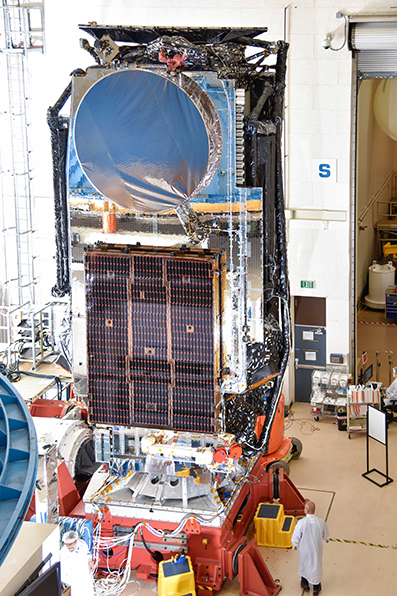There’s a Whole Lot of Shakin’ Going On: JUPITER 3 Undergoes Vibration and Acoustic Testing
Just how much shaking, rattling and noise does a satellite endure during launch and orbital flight? Enough to warrant extensive vibration and acoustic testing! These are just two of the rigorous tests the Hughes JUPITER™ 3 satellite endured over the past several months. Testing a satellite begins with each individual component, then each individual subsystem, then the connected the subsystems, and so on, to validate functional performance before the entire satellite is assembled.
A crucial phase of the manufacturing process is vibration testing, which mimics the launch environment to ensure the satellite can withstand the movement it experiences as it is thrust into space. Imagine the size and strength of the platform required to replicate the propulsion of a rocket launch while holding the satellite vertically!
Shake, Rattle and Roll!
The vibration test is akin to a massive earthquake, which shakes the spacecraft back and forth at 5 Hertz – that’s five back and forth movements per second. Engineers managing the test then raise the vibration level steadily until the satellite reaches its “resonant frequency” –– the apex where the satellite shakes wildly in a scenario mimicking the launch environment, and then starts to calm down.
With this round of vibration testing complete, the spacecraft was rotated and shaken in a perpendicular direction, followed by a round of up and down shakes. This continued for several rounds with results scrutinized by the spacecraft manufacturer and the launch provider, along with Hughes engineers.
Turn Up the Volume
After JUPITER 3 passed vibration testing, it was time for environmental acoustics testing -- another critical step because the energy from the sound of the launch is just as intense, if not more, than the vibration. Since JUPITER 3 needs to be able to withstand acoustics as loud as a heavy metal rock concert, Hughes enlisted the help of Maryland Sound International – Direct Field Acoustic Test (MSI-DFAT®). A sister company to Maryland Sound International – one of the world’s leading production companies that got its start doing acoustics for the likes of Frankie Valli and Pink Floyd – MSI-DFAT specializes in acoustic testing for satellites and aerospace structures.
MSI-DFAT hauled massive testing gear to the site and surrounded JUPITER 3 with a tower of speakers as tall as a building. Then they cranked them up to 145 decibels (a rock concert is around 100 decibels for reference!) and even higher, with teams once again monitoring hundreds of sensors and accelerometers on the spacecraft to confirm that everything worked as predicted even amid the acoustic barrage.
When the dust settled and the decibels declined, JUPITER 3 had once again demonstrated its readiness for the extraordinary conditions of its upcoming launch into space.
Join us in our countdown to the launch of JUPITER™ 3, the highly anticipated, next generation Ultra High Density Satellite (UHDS) that will dramatically expand the overall reach and capacity of the Hughes JUPITER fleet across the Americas.
